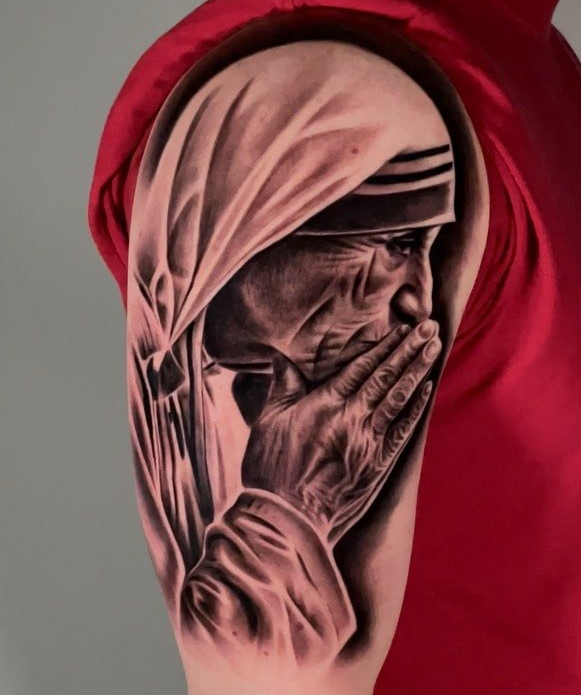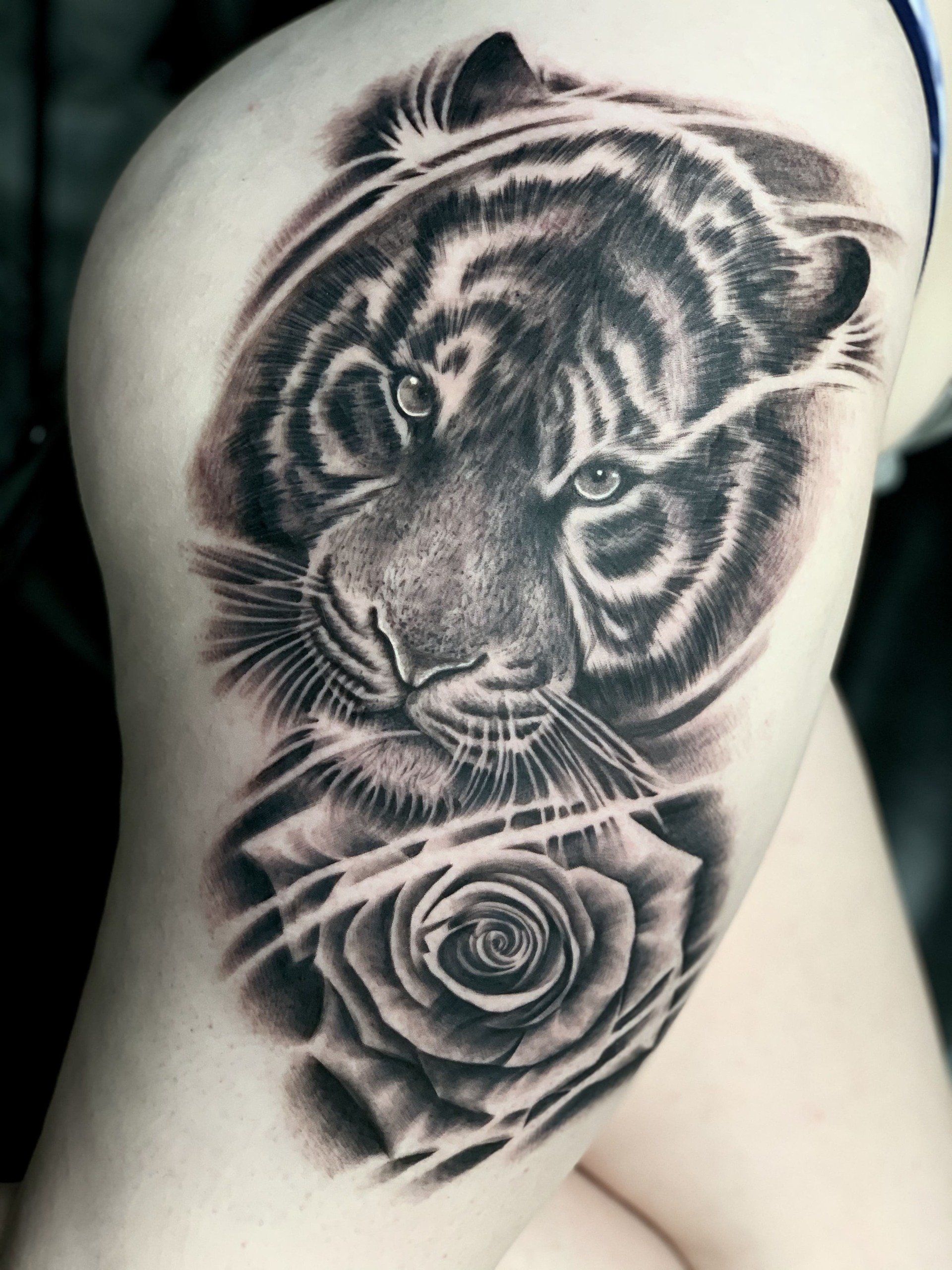Open For Business - Scheduling Daily 12p-8p
Covid Guidelines Here
Black and Grey Tattoos: The Ultimate Guide in 2023
Here you'll find the ultimate guide to black and grey tattoos, their origins as well as alternate names and benefits. Black and Grey Tattooing (also known as Black and Gray
with an “a” and synonymous with Black and White tattooing) is a practice that has spread through all of the world's cultures as a source of tremendous fascination for aficionados. For the
best black and grey tattoo artists, black & grey tattoos are a way of life. Because of the enthusiasm, passion, and dedication of professional tattoo artists, the art of black and gray tattooing is continuing to expand in creativity and excellence. Read along to learn everything you want to know about Black and Grey Tattoos, their benefits, and discover inspiring
black and grey tattoo ideas.
What Is The Full History of Black and Grey Tattoos?
Black and grey tattoos are often called Jailhouse tattoos because they are said to have originated in prisons in the 1970s, though actually their appearance is much older, with evidence of tattoos found on female mummies tracing back to ancient Egypt (2000 BC), and even presumed therapeutic tattoo patterns found on the joints of an Iceman called Otzi (3350 BC), whose mummified body was discovered dating back to the Copper Age. Some of the earliest written evidence is noted as far back as Leviticus circa 1444 BC (in the Bible), where Moses writes “Do not cut your bodies for the dead or put tattoo marks on yourselves (Leviticus 19:28).” In the latter case, scholars believe the earliest tattoos were given as a marking of enslavement and subservience to “the god” of the slave master. Thus, many cultures, even through the Greek and Roman eras, viewed tattoos as sacrilegious symbols of unholiness and slavery. Interestingly, though Moses forbids tattoos in order to condemn slavery and mastery by false gods, it is rarely mentioned by Bible scholars that the prophet Isaiah circa 700 BC, commends the art of tattooing as a symbol of devotion to the God of the Bible, writing, “One shall say, ‘I am the LORD’s… Another shall mark his arm ‘of the LORD' (Isaiah 44:5).” Undoubtedly, the practice of tattooing has been passed down through the ages, and in the former case, black and grey tattoos are thought to have been re-popularized by prison tattoos, jailhouse tattoos, or joint style tattoos in the 1970s, because inmates used the limited resources available in jail yards to pass the hours giving each other permanent reminders of their loved ones, deceased family and friends, affiliations and creeds. The jailhouse tattoo artists often used guitar strings for needles and cigarette ashes or pen ink to produce tattoos.
Fast forward to 2023 and the basic building blocks of tattooing, needles and black ink—with intricate shading—remain at the heart of all successful black and gray tattoos. Black and grey or black and white tattooing has naturally evolved over time while in many cases remaining symbolically faithful to its origins (meaningful artwork). As a result, the art and techniques that are being created today are truly breathtaking.
Why Shading Is So Important in Black and Grey Tattoo Techniques?
The primary aspect separating the best black and grey tattoo artists is their shading technique. The best tattoo artists understand the different variations for shading based on how they tune a tattoo machine, and mix the shading inks. Shading gives dimension to your tattoo, making it come alive in the eye of the observer, and is often achieved by tattoo artists working from darker to lighter areas of the tattoo. Utilizing multiple cups of ink, tattoo artists create many shades of black by diluting ink cups some with only black ink, and others with more or less water or white ink mixed in, which effectively gives them different shades of black and grey ink to work with on your tattoo (hence the name black and gray/white tattoos).
Excellent shading can also bring life to an old tattoo error that was not done right the first time. In fact, poor shading is the reason many people seek tattoo coverups. A tattoo artist with excellent technique can often correct an original tattoo that never had definitive shading or has faded because of improper methods, as well as creatively shading the old tattoo to create a new tattoo that is superior. Tuning the tattoo machine with the right speed is also vital in the process of shading, as slower speeds create lighter shades, while faster speeds return darker shades with more ink penetrating the skin at one time. When great technique is combined between the speed of the tattoo machine, the mix of the tattoo ink, and the shading of the tattoo on the skin, a vibrant black and grey tattoo will remain that stands the test of time.
The reason you always want to do your research before choosing a tattoo shop or tattoo artist, is to observe the longevity of the tattoo work being completed over time. While many tattoo artists are excellent tattoo designers, you may discover their design ink fails to hold up over time. Unfortunately, the effects of bad tattoo technique are the fading of your tattoo, and an undefined tattoo appearance as time goes on. Simply put, don't solely admire tattoo ideas, but as you research your next tattoo, talk to those who've been tattooed by the artist you're considering about how their tattoos look years later. The best tattoo artists use excellent shading technique because it sustains the contrast of your black and grey tattoo for the future. The basics of a great black and grey tattoo remain the same: does it pop off the skin with strong contrast, is it visible from a distance, does it hold up over time, and is it a cool looking tattoo?!
What Are Some Favorite Black and Grey Tattoo Styles?
- Realism Black and Grey Tattoos
Black and Grey Realism Tattoos, also called photorealism tattoos, are tattoos with elaborate and meticulous depictions of real people and situations with truth and accuracy to their actual image. The art movement that birthed realism began in France in the 1840s, in response and rejection of the subject matter of the Romantic Art Movement which focused on exotic emotional and dramatic representations.
Realism tattoos seek to create an image that is representative of exactly what the human eye sees, without doctoring the image or exaggerating any aspect of the person or subject.
When done well, black and grey realism tattoos are the exact representation of the subject, scenery, photograph, drawing or painting from which they are inspired.
- Portrait Black and Grey Tattoos
Portrait Black and Grey Realism Tattoos are the most popular style of black and grey tattoos, and
often depict a portrait of someone significant to the tattooee
(children, family members, mythological or movie characters, pop culture icons, etc), or favorite hobbies, objects, and natural scenery (sports, books, cars, motorcycles, nature, flowers, animals, etc). A portrait black and grey realism tattoo is also flexible because it can be blended with surrealistic elements combining the literal and the imaginary.
- Surrealism Black and Grey Tattoos
Black and Grey Surrealism Tattoos have grown in popularity as a means of expressing the unconscious mind, inking surrealistic images with boundary-less imagination, dreamlike imagery, and bizarre depictions that capture an independent, often spiritual, reality above or beneath our consciousness. The term "surreal" was coined by the poet Guilliame Apollinaire in the early 1920's as the surrealism movement ascended including famous artists like Salvador Dalí and Pablo Picasso. As with the original surreal movement, black and white surrealistic tattoos are characterized by out-of-the-ordinary, hyperrealistic, blended juxtapositions, and paradoxical abstract images.
- Old School Tattoos or Traditional Black and Gray Tattoos
Traditional black and grey tattoos are known also as Old School Tattoos, and they are defined by heavy outlines and more minimal shading--a blend of boldness and intricacy--that often carry nautical themes (ships, anchors, lighthouses, compasses with flowers, knives, sea creatures, message in a bottle etc). Black and grey traditional tattoo flash is common in many tattoo parlors, to help clients visualize an already existing tattoo design on the walls of the tattoo studio or in binders at the front desk. Sometimes these old school tattoo themes overlap with their close cousin borrowing imagery from American Black and Grey Tattoos (including Eagles, fighting barechested sailers, sirens, traditional pin up girls, etc).
- Western Tattoos or American Black and Grey Tattoos
A very similar and often synonymous style to Traditional black and grey tattoos is Western and American black and grey tattoos. What defines these black and grey tattoo styles differently is mostly thematic, as Western black and grey tattoos cover the western genre (cowboys, saloons, trains, the gold rush, pistols, Clint Eastwood, horseback riders, etc), and American black and grey tattoos cover the symbolism of traditional American culture (Native Americans, Eagles, United States Flag), as well as capturing American Zoomorphic black and grey tattoo themes (bears, wolves, owls, snakes, butterflies, panthers, tigers, cats, lions, etc).
- Fine Line Black and Grey Tattoos
Fine line black and grey tattoos are also known as thin line tattoos; and are extremely popular with millennials and Generation Z. Black and Grey fine line tattooing uses single needles (and 3RL needles) to create thinner lines then traditional black and grey tattoos. The goal of fine line tattoos is to create a detailed work of art that is as subtle as it is remarkable. Fine line and thin line tattoos are described as delicate, intricate, precise, and they are hyper-focused on detail, which makes every stroke of the tattoo pen more consequential. Whereas traditional black and grey tattoos pay more attention to shading, fine line tattoos require a very steady hand for fewer bold lines and more attentive line work. One style of fine line tattoos is a single line tattoo (also called a simple line tattoo), where your tattoo artist appears to have composed your black and grey fine line tattoo with one continuous line. Fine line tattoos are thought to be less painful than traditional styles of black and grey tattoos, and they tend to heal faster, though they also fade more aggressively.
Color Tattoo vs Black and Grey Tattoos?
Neo Traditional tattoos, New School tattoos, Watercolor tattoos and Japanese tattoos are all styles that lend well to color tattooing, while black and grey tattoos are better for old School and traditional tattoos, western and American tattoos, and realism and surrealism tattoos, which rely more on soft shading, fine outline details, a full range of black, and many shades of gray. With color tattoos the scale of your tattoo is more important, as a smaller tattoo with multiple colors can become muddy and undefined over time. We'd echo tattoo artist Nick Solomon, who wrote that black and grey tattoos are often better for smaller tattoos because "tighter and more detailed work tends to look better in black and grey." That said, larger pieces with colorwork can be beautiful, but not all tattoo artists are equal. You'll want to do your research to find the best color tattoo artists who incorporate brightness, hue, color integrity, and a simplified color palette, so that your ideal design is never in danger of becoming dirty.
- How Long Do Black and Grey Tattoos Last?
The longevity of great black and grey tattoo work is generally agreed to be superior to the colorwork of a color tattoo because the best black and grey tattoos can last a lifetime, and most go 15 years without any sign of fading. Black and grey tattoos--when done right--are said to age like fine wine because they naturally become a part of your skin over time, while standing out simultaneously. That said, it is not uncommon for tattoos--black and grey or color--to need a touch up over time.
- How Long Do Color Tattoos Last?
The main downside of color tattoos is their colors tend to fade more quickly over time, especially depending on the placement of your tattoo and whether it is exposed more often to the sun. In these cases, fading can occur 5-6 years after inking, or even more rapidly with watercolors. That said a great color tattoo artist may brighten your initial tattoo with more intensity at first, so that as it fades you'll achieve the natural color you want for the long haul, and with this technique alongside limited sun exposure, many report 10-20+ years of satisfaction with their color tattoos. Note: Some vibrant and pastel colors tend to dim more aggressively like watercolors, green, light blue, pink, and yellow. Nonetheless, both color tattoos and black and grey tattoos can experience priceless longevity when you're working with the best tattooers, who have foresight for the vitality of meticulous inking.
Can You Get A Black and Grey Tattoo Colored?
Yes, though you can't put color over solid black, you can add color around it to have it appear as if it were part of the original design. In many cases, you can get a black and grey tattoo colored after getting your ink, but the ideal is to decide ahead of time whether you want a color or black and grey tattoo. Certain tattoo style lend themselves better for colorwork like realism tattoos, geometric ink, Japanese tattooing, and neo traditional tattoos. In many styles, black and grey ink provides an excellent and defined outline for colorful tattoos.
a) If you haven't already gotten your black and grey tattoo but want it to morph over time with added color later, talk to your black and grey tattoo artist before you start your tattoo and inform them that you may be adding color in the future, this allows them to adjust their technique to make room for your future vision.
b) If you've already gotten your black and grey tattoo and want to add color, start by talking to a color tattoo artist about what you'd like to add, and they will let you know if it is possible.
c) If you already have a color tattoo and you want to change the colors, this is considerably more difficult and some color changes are not possible, that said, refreshing an old color tattoo is common practice.
Bottom line: every black and grey tattoo is different so do your research by finding several talented tattoo artists, and then ask how they would recommend accomplishing your vision of adding color.
Bottom Line on Black and Grey Ink
Black and grey tattoos continue to proliferate mass culture and gain popularity with men and women because of their classic origins, excellent methods, flexible styles, creative and powerful imagery, as well as trustworthy longevity. Always do your research to choose the best black and grey tattoo artist for your ink, and know in advance how to communicate your piece to your tattooer. Then reach out to the artist or their tattoo shops, and book your consultation.
If you're in the Fayetteville, NC area, see Jose Torres Tattoo for all your black and grey ink work.


























